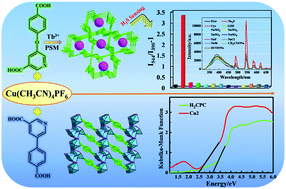当前位置:
X-MOL 学术
›
J. Mater. Chem. C
›
论文详情
Our official English website, www.x-mol.net, welcomes your
feedback! (Note: you will need to create a separate account there.)
A highly sensitive turn-on ratiometric luminescent probe based on postsynthetic modification of Tb3+@Cu-MOF for H2S detection
Journal of Materials Chemistry C ( IF 5.7 ) Pub Date : 2017-09-04 00:00:00 , DOI: 10.1039/c7tc02430d Xubin Zheng 1, 2, 3, 4 , Ruiqing Fan 1, 2, 3, 4 , Yang Song 1, 2, 3, 4 , Ani Wang 1, 2, 3, 4 , Kai Xing 1, 2, 3, 4 , Xi Du 1, 2, 3, 4 , Ping Wang 1, 2, 3, 4 , Yulin Yang 1, 2, 3, 4
Journal of Materials Chemistry C ( IF 5.7 ) Pub Date : 2017-09-04 00:00:00 , DOI: 10.1039/c7tc02430d Xubin Zheng 1, 2, 3, 4 , Ruiqing Fan 1, 2, 3, 4 , Yang Song 1, 2, 3, 4 , Ani Wang 1, 2, 3, 4 , Kai Xing 1, 2, 3, 4 , Xi Du 1, 2, 3, 4 , Ping Wang 1, 2, 3, 4 , Yulin Yang 1, 2, 3, 4
Affiliation

|
The fabrication of luminescent materials with lanthanide cations encapsulated within MOF pores is currently of interest because luminescent materials are used in numerous applications. In this study, a distinctive strategy via postsynthetic modification (PSM) of a novel metal–organic framework [Cu(HCPOC)2]n (Cu1) (H2CPOC = 5-(4′-carboxyphenoxy)nicotinic acid) and terbium ions (Tb3+) for sensing hydrogen sulfide (H2S) is reported. The obtained composite Tb3+@Cu1 emits a weak typical Tb3+ ion emission and strong ligand-centred emission. Interestingly, H2S, as a strong electron donor, can strongly enhance the luminescence of Tb3+ through its superior affinity for Cu2+ ions. The composite Tb3+@Cu1 was designed as a luminescent turn-on ratiometric probe for H2S detection, showing high sensitivity and selectivity. The detection limit of Tb3+@Cu1 (1.20 μM) is far below that of Cu1 (13.25 μM). Moreover, a similar ligand, 5-(4′-carboxyphenyl)nicotinic acid (H2CPC), was used to synthesize a fascinating structure, [Cu5(CPC)2(HCPC)2(OH−)4]n (Cu2), which was quite similar to that of the famous semiconductor MoS2, with the advantageous support of an organic linker between layers, and it showed a band gap of 2.45 eV.
中文翻译:

基于Tb 3+ @ Cu-MOF合成后修饰的H 2 S检测高灵敏开启比例发光探针
由于在许多应用中使用了发光材料,因此目前正在关注具有在MOF孔内封装的镧系元素阳离子的发光材料的制造。在这项研究中,通过新型金属-有机骨架[Cu(HCPOC)2 ] n(Cu1)(H 2 CPOC = 5-(4'-羧苯氧基)烟酸)和ter离子的合成后修饰(PSM)的独特策略报道了用于感测硫化氢(H 2 S)的(Tb 3+)。所得的复合物Tb 3+ @ Cu1发射出的典型Tb 3+离子发射弱,而以配体为中心的发射强。有趣的是,H 2S作为强电子给体,可通过其对Cu 2+离子的超强亲和力来大大增强Tb 3+的发光。复合Tb 3+ @ Cu1被设计为用于H 2 S检测的发光开启比例探针,显示了高灵敏度和选择性。Tb 3+ @ Cu1(1.20μM)的检测限远低于Cu1(13.25μM)的检测限。此外,类似的配位体,5-(4'-羧基苯基)烟酸(H 2 CPC),用于合成一个引人入胜的结构,[铜5(CPC)2(HCPC)2(OH - )4] n(Cu2)与著名的半导体MoS 2十分相似,在层间有机连接基的有利支撑下,其带隙为2.45 eV。
更新日期:2017-09-19
中文翻译:

基于Tb 3+ @ Cu-MOF合成后修饰的H 2 S检测高灵敏开启比例发光探针
由于在许多应用中使用了发光材料,因此目前正在关注具有在MOF孔内封装的镧系元素阳离子的发光材料的制造。在这项研究中,通过新型金属-有机骨架[Cu(HCPOC)2 ] n(Cu1)(H 2 CPOC = 5-(4'-羧苯氧基)烟酸)和ter离子的合成后修饰(PSM)的独特策略报道了用于感测硫化氢(H 2 S)的(Tb 3+)。所得的复合物Tb 3+ @ Cu1发射出的典型Tb 3+离子发射弱,而以配体为中心的发射强。有趣的是,H 2S作为强电子给体,可通过其对Cu 2+离子的超强亲和力来大大增强Tb 3+的发光。复合Tb 3+ @ Cu1被设计为用于H 2 S检测的发光开启比例探针,显示了高灵敏度和选择性。Tb 3+ @ Cu1(1.20μM)的检测限远低于Cu1(13.25μM)的检测限。此外,类似的配位体,5-(4'-羧基苯基)烟酸(H 2 CPC),用于合成一个引人入胜的结构,[铜5(CPC)2(HCPC)2(OH - )4] n(Cu2)与著名的半导体MoS 2十分相似,在层间有机连接基的有利支撑下,其带隙为2.45 eV。











































 京公网安备 11010802027423号
京公网安备 11010802027423号